Hexagonal Chess Notation
by Arnaldo Rodrigues DAlmeida
Inventor of the REX chess
e-mail: (email removed contact us for address) .com.br Webmaster www.geocities.com/xadrezrex
1- NOTATION
The notations goal is to register the moves of a game. The analysis of the games, move by move, will allowthe player to learn the tactics and opponent's strategies. Besides, you can notice your mistakes and successes, what will contribute to improve your performance.
The notation consists in describing the origin positions and destiny of the piece that was moved. The representation of those positions is made by Cartesian coordinates. Cartesian notation is based on two orthogonal axes coordinates. The Cartesian coordinates are formed by the numeration or ordering of letters of the ranks and files.
There are hexagonal chess boards that don't have files like in a traditional chess (for example: REX and Chessex - see forward), however, files will be considered the group of hexagons disposed in the vertical and aligned in straight line that crosses hexagons from corners. Theses hexagons have the same color.
REX

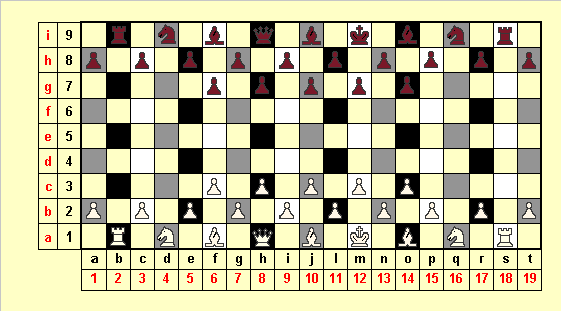
Others hexagonal chess boards don't have ranks like in a traditional chess (for example: Glinski, and Hexabeast see forward), however, ranks will be considered the group of hexagons disposed in the horizontal and aligned in straight line that crosses hexagons from corners. Theses hexagons have the same color.
I suggest that all hexagonal chess variants use the Cartesian notation, as REX chess. This notation system has some advantages:
1- Practical notation - You can write the moves of the matches without removing the piece from the board (for example: Glinski chess);
2- Standard notation - It is possible to use this notation for all chess variants that use hexagonal or square cells;
3- Easy notation - Except for a large board, it is possible to represent the move with only 4 symbols (letters and/or numbers), 2 represent the initial position and 2 represent the final position;
4- Movement previews - It allows correlating, by equations, the movements of the pieces, what is fundamental in computers programs (see forward);
5- Similarity with chess The traditional chess and square chess variants (small and large boards) use the same notation.
Some hexagonal chess variants use the notation based on two axes non orthogonal coordinates, as in Hexabeast Chess (see figure below).
Hexabeast Chess
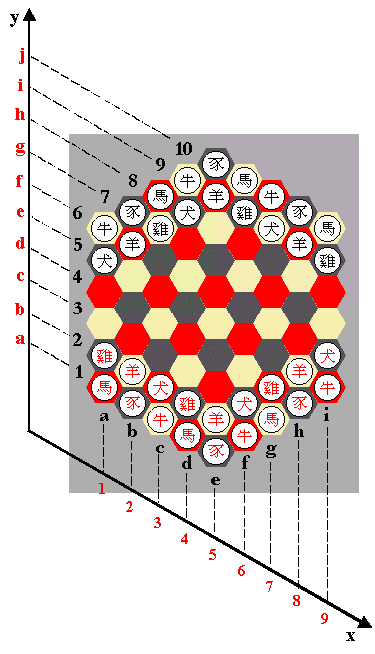
The figure below shows Hexabeast Chess with Cartesian notation as suggested by the author.

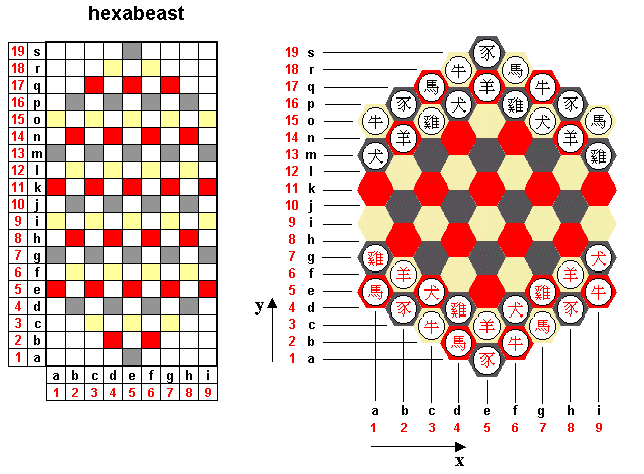
There are two basic moves which can describe the movement of all pieces:
Orthogonal move: a move wherein a piece moves in straight line that crosses hexagons from orthogonal sides. Orthogonal moves always go through hexagons of different colors (Rook).
Diagonal move:a move wherein a piece moves in straight line that crosses hexagons from corners. Diagonal moves always go through hexagons of the same color (Bishop).
Note: The Knight move is a composed move. It moves one cell as Bishop and another as a Rook, or vice-versa, but the second move shall be to the same direction as the first one. For example: Knight can be moved 1 hexagon along diagonal and 1 forward hexagon along orthogonal.
When the notation is based on two axes coordinates, it is possible to preview all possibilities of movements of the pieces by equations.
2.1- Cartesian Notation
2.1.1- Hexagonal chess boards don't have files (REX, Chessex and others)
Initial position: (x, y)
Final position: (xf, yf)
Rook
Horizontal direction: (xf, yf) = (x ± 2n, y)
Diagonal direction: (xf, yf) = (x ±n, y ±n)
n=[1, 2, 3, )
Bishop
Vertical direction: (xf, yf) = (x, y ± 2n)
Diagonal direction: (xf, yf) = (x ± 3n, y ±n)
n=[1, 2, 3, )
For example: Bishop on REX chess board is on d3 (initial position, see the figure below)


Question: Which are all moves bishop can do?
Answer: Initial position: d3= (4, 3)
Vertical direction:
n = 1
==>
(xf,
yf)
= (4, 1) =
d1 or (4, 5) = d5;
n = 2
==>
(xf,
yf)
= (4, 7) =
d7;
n = 3
==>
(xf,
yf)
= (4, 9) =
d9;
Diagonal direction:
n = 1
==>
(xf,
yf)
= (1, 2) = a2, (1,
4) = a4, (7, 2)
= g2 or (7, 4) = g4;
n = 2
==>
(xf,
yf)
= (10, 1) = j1 or (10, 5) = j5;
n = 3
==>
(xf,
yf)
= (13, 6) =
n6;
n = 4
==>
(xf,
yf)
= (16, 7) =
q7;
n = 5
==>(xf,
yf)
= (19, 8) =
t8;
2.1.2- Hexagonal chess boards don't have ranks (Glinski, Hexabeast and others)
Initial position: (x, y)
Final position: (xf, yf)
Rook
Vertical direction: (xf, yf) = (x, y ± 2n)
Diagonal direction: (xf, yf) = (x ±n, y ±n)
n=[1, 2, 3, )
Bishop
Horizontal direction: (xf, yf) = (x ± 2n, y)
Diagonal direction: (xf, yf) = (x ±n, y ± 3n)
n=[1, 2, 3, )
For example: Bishop on Glinski chess board is on eh (initial position, see the figure below)
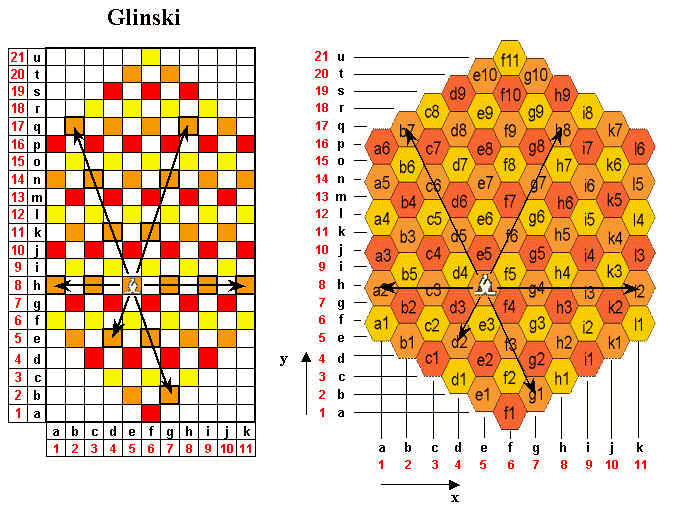
Question: Which are all moves bishop can do?
Answer: initial position eh= (5, 8)
Horizontal direction:
n = 1
==>
(xf,
yf)
= (3, 8) = ch or (7, 8)
= gh;
n = 2 ==>
(xf,
yf)
= (1, 8) = ah or (9, 8)
= ih;
n
= 3 ==>
(xf, yf) = (11,
8) =
kh;
Diagonal direction:
n
= 1 ==>
(xf,
yf)
= (4, 5) = de, (4,
11) = dk, (6, 5)
= fe or (6, 11) = fk;
n = 2
==>
(xf,
yf)
= (3, 14) = cn, (7, 2)
= gb or (7, 14) = gn;
n
= 3 ==>
(xf, yf) = (2,
17) = bq or (8, 17) = hq;
2.2- No Cartesian Notation (based on 2 non orthogonal axes)
Initial position: (x, y)
Final position: (xf, yf)
For Chessex (see Figure below)
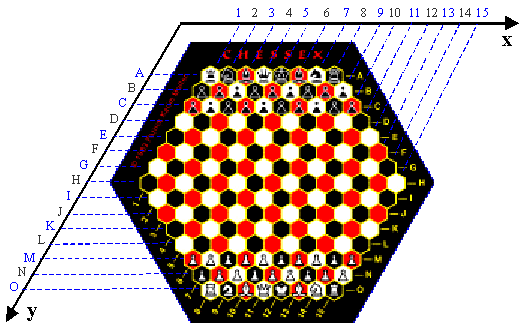
Rook
Horizontal direction: (xf, yf) = (x ±n, y)
Diagonal direction: (xf, yf) = (x, y ±n), (x - n, y - n) or (x +n, y +n)
n=[1, 2, 3, )
Bishop
Vertical direction: (xf, yf) = (x -n , y - 2n) or (x +n , y + 2n)
Diagonal direction: (xf, yf) = (x -n, y + n), (x - 2n, y - n), (x +n, y - n) or (x + 2n, y + n)
n=[1, 2, 3, )
For example: Bishop on an empty Chessex chess board is on 9M (initial position, see the figure above)
Question: Which are all moves bishop can do?
Answer: initial position 9M= (9, 13)
Vertical direction:
n = 1
==>
(xf,
yf)
= (8, 11) = 8K
or (10, 15) = 10O;
n = 2
==>
(xf,
yf)
= (7, 9) =
7I;
n = 3
==>
(xf,
yf)
= (6, 7) =
6G;
n = 4
==>
(xf,
yf)
= (5, 5) =
5E;
n = 5
==>
(xf,
yf)
= (4, 3) =
4C;
n = 6
==>
(xf,
yf)
= (3, 1) =
3A;
Diagonal direction:
n = 1 ==>
(xf,
yf)
= (8, 14) = 8N, (7,
12) = 7L, (10, 12)
= 10L or (11, 14) = 11N;
n = 2
==>
(xf,
yf)
= (5, 11) = 5K, (11, 11)
= 11K or (13, 15) =
13O;
n = 3
==>
(xf,
yf)
= (3, 10) = 3J or (12, 10) = 12J;
n = 4
==>
(xf,
yf)
= (13, 9) =
13I;
n = 5
==>
(xf,
yf)
= (14, 8) =
14H;
Contact
(email removed contact us for address) .com.br
Written by Arnaldo Rodrigues D'Almeida.
WWW page created: September 23, 2002.